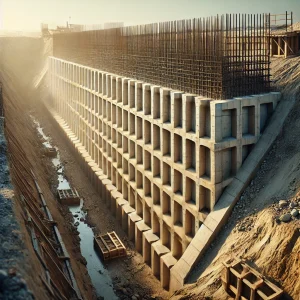In geotechnical engineering, the seismic design of cantilever retaining walls is a critical task that requires a balance between safety and cost-effectiveness. Traditional methods, such as the Mononobe-Okabe (M-O) approach, have been the industry standard for estimating seismic earth pressures. However, recent research suggests that geotechnical codes may overestimate the horizontal (kh) and vertical (kv) seismic earth pressure coefficients in these simplified methods, leading to overly conservative designs.
The Overestimation of Seismic Coefficients
Research has indicated that the M-O method may lead to conservative designs due to:
- Overestimated Seismic Coefficients: Codes often set high kh and kv values based on peak ground acceleration (PGA), assuming maximum acceleration throughout the seismic event. This doesn’t account for the actual dynamic response over the wall’s height, resulting in excessive pressure estimates.
- Simplification of Soil-Wall Interaction: The M-O method doesn’t fully consider the complex interactions between soil properties and wall stiffness under seismic conditions. Numerical simulations have shown discrepancies between calculated M-O pressures and observed pressures, particularly in walls with varying soil properties or nonlinear responses.
Modern Approaches and Recommendations
To address these concerns, modern codes and research suggest:
- Reducing kh Based on Displacement Tolerance: For walls that can tolerate some movement, reductions in kh are justified. Guidelines like those from AASHTO indicate that the seismic coefficient kh can be adjusted based on allowable displacements, preventing over-conservatism while ensuring stability under realistic seismic demands.
- Assuming kv = 0: Due to the decoupling of seismic accelerations, when one component is large, the other is almost zero. It’s common practice to assume kv = 0 in design calculations, simplifying the analysis without significantly affecting accuracy.
Step-by-Step Procedure for Determining kh and kv Using GEO5
Step 1: Define Seismic Input Parameters
- Obtain Peak Ground Acceleration (PGA): Use seismic hazard maps or local codes to find the PGA for your site.
- Determine Site Class and Soil Profile: Classify the soil to estimate amplification effects, as some standards require PGA adjustments based on site class.
Step 2: Determine the Horizontal Seismic Coefficient (kh)
- Initial Estimate: Start with kh as a fraction of the PGA. A common initial value is kh = 0.5 * PGA.
- Adjust Based on Displacement Tolerance:
- For walls tolerating larger displacements (flexible walls), reduce kh (e.g., kh = 0.33 * PGA).
- For walls with minimal displacement tolerance (rigid walls), maintain kh ≈ 0.5 * PGA.
Step 3: Assume kv = 0
- Due to the decoupling effect, set kv = 0 for the calculations.
Step 4: Input Data into GEO5
- Enter Soil Parameters: Input accurate soil properties (unit weight, friction angle, cohesion, etc.).
- Define Wall Geometry: Specify the dimensions and material properties of the retaining wall.
- Apply Seismic Loads: Input the calculated kh and set kv = 0 in the seismic load settings.
- Use Adaquate Methods of Calculation and Parameters: Such as active condition due to displacement allowance, in regard to the friction angle, you may use AASHTO´s assumption of 2/3 of the soil friction angle, etc.
Step 5: Perform the Geotechnical Analysis
- Check Equilibrium and Sliding Stability : Ensure the factor of safety (FoS) against sliding is greater than 1.1 under seismic conditions.
- Overturning Stability: Check that the FoS against is acceptable.
- Bearing Capacity: Verify that the soil bearing capacity is adequate under seismic loading.
Step 6: Check the Structure and Reinforcement
- Adjust Wall Dimensions: Modify the wall design if material criteria accoriding to the selected code are not met.
- Optimize Material Use: Aim for an efficient design that meets safety requirements without over-conservatism.
Step 7: Iterate Design as Necessary
- Adjust Wall Dimensions: Modify the wall design if stability criteria are not met.
- Optimize Material Use: Aim for an efficient design that meets safety requirements without over-conservatism.
Step 8: Document Assumptions and Parameters
- State Assumptions Clearly: Justify the reduction of kh and the assumption of kv = 0 based on displacement tolerance and code recommendations.
- Reference Codes and Guidelines: Cite relevant standards (e.g., AASHTO) that support your design approach.
Advantages of Using GEO5 in Seismic Design
- Enhanced Accuracy: GEO5 allows for detailed modeling of soil-structure interaction, improving the precision of seismic analyses.
- Efficiency: By preventing overestimation of seismic forces, GEO5 helps optimize material usage and reduce construction costs.
- Compliance with Modern Codes: GEO5’s features align with the latest guidelines, ensuring designs meet current safety standards.
- User-Friendly Interface: The software’s intuitive design streamlines the analysis process, saving time for geotechnical engineers.
Limitations and Considerations
- Accurate Displacement Assessment: The reduction of kh depends on reliable predictions of allowable wall displacements.
- Site-Specific Constraints: In areas with high seismicity or soils prone to liquefaction, conservative kh values may still be necessary.
- Professional Judgment Required: Engineers must carefully consider site conditions and use their expertise when applying reduced seismic coefficients.
Conclusion
The seismic design of cantilever retaining walls is evolving with advancements in computational geotechnics. By re-evaluating the seismic earth pressure coefficients and utilizing powerful tools like GEO5, geotechnical engineers can achieve designs that are both safe and cost-effective. Incorporating reduced kh values based on displacement tolerance, while assuming kv = 0, aligns with modern research and code recommendations, optimizing the balance between safety and efficiency.
Ready to enhance your seismic design capabilities with GEO5?
Visit GEOTEK.academy for expert insights and training computational geotechnics. Our platform is dedicated to helping geotechnical engineers stay at the forefront of industry practices.


